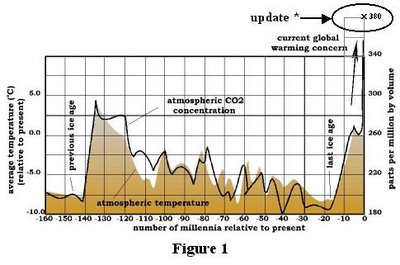Last January I ran off a
shirttail calculation estimating the weight of carbon dioxide in
the Earth's atmosphere (280 gigatonnes), and
compared it with the weight of methane trapped in the
world's permafrost (also 280 gigatonnes).
While methane has 22 times the global warming effects of carbon
dioxide, it has a half-life in the atmosphere of only about 8
years. If this outgassing of AlCan and Siberian tundras took
place completely but slowly, it would release something like 280
gigatonnes of methane that would convert to CO2 over a
period of decades. But what I didn't consider
was the fact that a tonne (metric ton) of methane, with a
molecular weight of 14, would oxidize to a little over three
metric tones of CO2, with a molecular weight of 44. So
the 280 gigatonnes of methane would become 880 gigatonnes of
CO2, or about 3 times the 280 gigatonnes of
CO2 in the Earth's atmosphere
today. That's not good news. That would
quadruple the amount of CO2 in the
Earth's atmosphere. I also mentioned the
lesser possibility that the methane clathrates
("methane ice" deposits at the
bottom of the world's oceans contain about
10,000 gigatonnes of methane, and that would convert to about
31,500 gigatonnes of CO2, and that this is thought to
have occurred during the Mesozoic/Cenozoic Thermal Maximum that
killed off the dinosaurs about 55,000,000 years ago. That
wouldn't be the best prognosis for humanity,
but at least it didn't transform the world
into a searing hell like Venus.
It's important to be aware that the outgassing
of methane hasn't yet been included in
existing climate simulations, or at least in the forecasts that
we're hearing right now.
That was the good news. Now for the bad news.
It has just been announced that the rate of rise of atmospheric
CO2 has more than 2.5-folded since
1990…. the fourth consecutive year of
two-parts-per-million growth. Last year, 7.85 gigatonnes of
CO2 was added to the atmosphere compared to 6.87
gigatonnes in 2000.
A month ago, several news sites reported that in the latest
annual report on climate change, issued last spring, it was
erroneously concluded that methane release into the atmosphere
had slowed down. In fact, it has continued to increase, but this
fact was learned too late to correct it in the report. Now, in a
display of "media
Alzheimer's disease" the same
media are reporting the incorrect earlier message that the
methane release rate has fallen.
In the meantime, the rate of methane release from Arctic
permafrost is rapidly accelerating.
To clothe methane release rates in numbers, suppose that methane
is being released at the rate of 0.1% a year. At that rate, it
would take 1,000 years for all the world's
permafrost to outgas. Since there's an
estimated 280 billion tones of methane locked up in the
world's tundras, 0.1% a year would translate
into a release rate of 280 million tones of methane a year. Given
that methane has 22 times the greenhouse effect of
CO2, this rate of release would equate to about 6
gigatonnes of CO2a year in terms of greenhouse
effects, or about 3/4that of last year's
CO2release. (Note that after 8 years, half of the
integrated total of 2.24 gigatonnes (= 1.12 gigatonnes) of
methane released over the 8-year half-life of this atmospheric
methane would have converted to 3.15/22 tonnes of CO2,
raising the global CO2burden by 3.5 gigatonnes of
CO2.in 8 years. This would still be small compared to
the 64 gigatonnes of CO2 added to atmosphere from
other sources. )
Clearly, even an outgassing rate of only 0.1% a year
isn't happening yet, or the effects would be
more evident. However, we might expect that the warmer the Arctic
gets, the faster the permafrost will outgas.
What's so alarming about the outgassing of
permafrost is the fact that it would be a case of global warming
feeding upon itself. Although our burning of fossil fuels would
have initiated this process, outgassing of methane could,
possibly, continue to elevate CO2levels even if we cut
our fossil fuels emissions to zero.
This last summer, for the first time, a passage opened up through
the sea ice all the way to the North Pole. This was a fluke, but
it appears to be a harbinger of things to come.
Kerry Williams has brought up an interesting point, and has
buttressed his case with computations. His calculations indicate
that climate change is coming on too rapidly to permit trees to
migrate toward the poles as fast as the global-warming-induced
changes in their habitats. This could lead to an ecological
crisis in which oxygen renewal might take a hit.
My personal prognosis-one that I try not to
think about-is that we will pass the
"tipping point" if we
haven't already passed it, at which runaway
global warming occurs no matter what we do. Conservation can help
us reduce our fossil fuel demands somewhat, but some fuel
guzzlers like 18-wheel transfer trucks are probably already about
as efficient as they can currently be made, and our civilization
depends upon our ability to haul freight. Even if we can reduce
our CO2output to some 20th-century level,
CO2would continue to rise.
I suspect that sometime within the next decade,
there's going to be panic in the streets over
this. Venture capitalists are already pouring money into solar
power startups. Semiconductor-grade silicon is currently a
bottleneck in solar cell production, and the prices of solar
cells have risen rather than fallen over the past two years, due
in part to Germany's subsidization of solar
power and to California's
"million solar rooftops"program.
In the meantime, solar technology is in a state of ferment. (The
best investment plays might lie in supporting technologies such
as batteries, power inverters, or mounting hardware.) Within ten
years, we might have high-efficiency, low cost solar rooftops
that are natural looking and are fashionably accepted within the
neighborhood. Production of vehicle fuels might be another
application of solar power. For countries that have extensive
electrical grids, solar arrays may take hold in central power
systems in sun-belt regions rather than in the form of
distributed rooftop power.
Another promising area is battery research. Long-lived
rechargeable batteries that store a kilowatt-hour per kilogram
may be in the offing. These are being suggested for hybrid
vehicles that can plug into the wall for recharging. (Some
amateurs are beefing up the lead-acid batteries in their Priuses
for short around-town jaunts on electric power only, with plug-in
recharging back home.) A typical home uses about 40
kilowatt-hours of energy a day, although careful design can
reduce that number. At that rate, 100 kilograms of batteries
could probably provide for a household.
Wind power offers promise along coastlines and in mountainous
areas.
Biodiesel generated from cellulose waste requires some further
bioengineering of microbes, but that might become a way to
generate vehicle fuels. (I suspect that some combination of
ethanol and biodiesel generation may be the wave of the future
rather than hydrogen fuel cells. We already have a century of
experience and infrastructure in place for the internal
combustion engine. But we'll see.)
Nuclear power is an immediate short-term solution to power
requirements, but one would hope that we would step on the
accelerator with respect to converting to alternate energy
solutions, bypassing nuclear power. In any case, it will take
years to build new nuclear power plants. Meanwhile, in spite of
efforts to convert to alternate energy sources, China is planning
to rely almost entirely on new coal-fired power plants for its
burgeoning power goals. But I suspect that this plan may be
overtaken by the
"pani-in-the-streets"
If the "panic in the streets"
scenario occurs at some future time, I could imagine southern
property falling in value, and northern property values rising,
as people try to relocate themselves in anticipation of rising
temperatures. Commercial installations would be shifted
northward, and residential acquisitions would follow. In North
America, land along the northern Pacific coast, and in Canada and
Alaska would seem to me to be especially valuable.
The UK science magazine, "New
Scientist"has taking the unusual step of describing
the well-funded global warming disinformation program that has
been mounted by Exxon, General Motors, and Ford Motor
Company-a campaign that is reminiscent of the
disinformation programs financed by the tobacco and dairy
industries that deliberately obfuscated the dangers of smoking
and dairy products during the 60's and
70's..
Some Thumbnail Calculations
An object in interplanetary space will arrive at an equilibrium
temperature at which the radiation power absorbed from the sun
equals the radiation power re-radiated by the object. The total
radiation power absorbed from the sun by a spherical
"black body"(perfect absorber) is
given by πr2 times the power per unit area.
For a spherical black body in the vicinity of the Earth, the
power absorbed from the sun is given by the solar constant =
1,370 watts/square meter. The power re-radiated back into space
will be spread over the entire surface of the sphere =
4πr2. This means that the re-radiated power
density will be exactly ¼th of the power density received
from the sun, or 1,370/4 w/m2 = 342.5 w/m2.
Then we can plug this number into the Stefan-Boltzmann equation,
Power/m.2 = 5.67 X 10-8 T4, and
solve for the equilibrium temperature at which the Earth
re-radiates the same amount of power/m.2 it receives
from the sun. The resulting black-body equilibrium temperature is
278.8º Kelvin or 5.65º Celsius or about 40 degrees
Fahrenheit. In reality, there are many complications that muddy
these waters. There is cloud cover, atmospheric convection, and
uneven surface and cloud top temperatures, to name just three.
Dr. Angell de la Sierra has raised the question: if
CO2blocks heat radiation from the ground, why
doesn't it also block the incoming radiation
from the sun? I believe that this asymmetry may arise because the
radiation from the sun peaks at a wavelength of about ½
micron, whereas radiation emanating from the Earth peaks in the
far infrared at a wavelength of about 10 microns. The atmosphere
is transparent to visible and near-infrared radiation, whereas it
is, perhaps, semi-opaque in the far infrared. Dr. de la Sierra
also observed that the situation must be complicated. Convection
patterns would play a role. If atmospheric CO2is
semi-opaque to far-infrared radiation, it can do so either by
reflecting it or by absorbing it. If it reflects far-infrared
radiation, then it would tend to re-radiate less radiant heat
than the corresponding black body, and this would certainly have
a warming effect. If atmospheric CO2is semi-opaque
because it's a good absorber differential in
the 5 to 15 micron range, then it would heat up. At the same
time, the effective temperature of the radiating surface would
tend to be low because the radiating surface would be high in the
Earth's atmosphere, which is where convection
enters the picture. Also (Dr. de la Sierra pointed out),
atmospheric CO2might radiate from lower levels as well
as higher levels, complicating the situation further.
If the Bush Administration's denial of the
reality of global warming and deliberate inaction destroys
humanity, it will be the greatest crime against humanity ever
committed.
Time will tell.






















